26 That’s Right 26 Selections Of The Greatest Circus Movies On Earth!
Part III: Spectacle
We resume my grandfather Dean Mory’s circus saga at the time of his retirement in the late ’60s from coaching gymnastics and teaching phy. ed. at UW-Madison. For the past several years, Grandpa had offered a popular Circus Class elective on the second floor of the UW’s Red Gymnasium – its course listing of “Performance Theory and Methodology in the Modern Circus” once even earning mocking mention by Johnny Carson on The Tonight Show – and was called back three semesters after his final year to handle the enrollment overload from previous semesters.
Appropriate to his own introduction to circus performing 40 years before, courtesy of former Ringling Brothers clown and performer Bill Schultz, where his Manitowoc, WI after-school “Billy Lester’s Circus School” had taught my natural athlete and high school football star grandfather the rudiments of juggling, hand-balancing, trapeze, and other circus-related activities, Grandpa had continued the legacy of his mentor in his own capacity as educator. And it was in this latter capacity that Schultz’s son Bill Schultz, Jr., a talented performer in his own right, and who had recently taken over the directorship of Baraboo, WI’s Circus World Museum, approached Grandpa Dean about setting up a similar sort of summer program for the youth of Baraboo.
“Circus” and “Wisconsin” goes back to when the Ringling family settled in Baraboo in 1875, with five handsomely-mustachioed siblings founding a traveling circus empire that began touring in 1884 as the Ringling Brothers – “World’s Greatest Circus” – and, by 1906, having bought out the largest circus combination in America, became The Ringling Bros. and Barnum & Bailey Circus, “The Greatest Show On Earth”. The mammoth show’s winter headquarters – storing equipment and tending animals during its off-touring season – had been stationed on Ringling family land in Baraboo from its first touring season until 1918, when its operation base moved far south to Sarasota, Florida. The long-fallow site of its original warehouses and liveries became the Circus World Museum in 1954, a state-owned tourist site today celebrating its 63rd year; which in addition to holding one of the country’s largest exhibits of circus wagons, posters, costumes, and other artifacts and research materials, has also featured live Big Top performance and exotic animal menageries for most of its seasons of operation.
With co-workers like Happy the Clown and a circus wagonmaster and general handyman named “Heavy”, Grandpa and the second Bill Schultz, who also functioned in those years as the museum circus show’s ringmaster, sought to restore some of the old performing and spectacle magic of those Golden Circus Age days of yore. And for those Baraboo-area kids too young to find summer break employment with Central Wisconsin’s burgeoning tourist industry, the local 8 – 12-years-old instead found an 8-week crash course under the museum’s Big Top in everything “circus”: from high-flying trapeze work, rope-twirling, and trampoline routines to rope-tying, spotting, and rigging; from juggling, hand-balancing, and gymnastics floorwork to clowning, concession stand-hawking, and ticket-taking; from globe-balancing, unicycling, and tightrope-walking to makeup, costume-making, and roustabout work. And for those musically-inclined, the program offered a few chairs on the circus museum’s live brass band: the essential time-keeper and between acts-filler of the classic Big Top show.
“Spec” is old circus lingo for the promenade of animals and performers, outfitted in spangles, sequins, shining robes, gowns, and capes, that precedes the first act entrance of the entire company into the main ring. More than merely introducing the circus company and the acts about to take place, the Spec’s purpose is to overwhelm the Big Top audience with a panoramic parade of knockabout clowns, elaborate costumes, and trained animal processions; to in effect make the audience feel that they are somehow part of the show.
Though my grandfather’s circus program for the kids in Baraboo only lasted three years, he did nonetheless succeed in pulling off a great Spec for their parents, and in fact the entire town, at the end of each summer. And I don’t think this is any small accomplishment. The circus itself pulls together every form of live performance that had developed across regions, countries, and even continents for centuries – from the traveling caravan to the seasonal carnival, from town theater and the freak sideshow to magic shows and street busking – and the spectacle of a 3-ring parade is at the heart of a truly big show.
As a small child in Appleton, WI, one of grandpa’s first memories was of himself, his infant sister, and mother seeing his dad off to war in the late spring of 1917. On a cold morning in mid-April, several hundred of the town’s sons assembled on Main Street and marched in baggy gray files, woodstock rifles slung over sackcloth shoulders, towards the railway depot. By a strange coincidence, this was the very day the circus came to town; so as the U.S. Army loaded up the promising male youth of Appleton towards war, the circus – Grandpa never remembered which, but it didn’t really matter – was unloading wagons, miles of tent canvas, and crates upon crates of costumes, equipment, and steel rigging. The great circus Spec that in colorful rows paraded down the same thoroughfare later that afternoon offered a strangely wonderful counter-procession to the grimmer spectacle the town center had witnessed earlier that same day.
I suspect at least some of this real-life magic made it into the shows Grandpa Dean put on 55 years later for the children of Baraboo, the very site where the Greatest Show On Earth was born. If nothing else, the Children’s Spec of Baraboo’s Circus World Museum was the realization of a lifelong obsession that began the day grandpa both watched his dad march off to war and saw the circus come to town.

…
“Spectacle” does indeed provide the overarching theme for our third collection of circus movies, the panache, pageantry, and poetry of the Great American Circus finding its most potent expression in a packed parade of overwhelming sights, sounds, and scenes. From the flea menagerie to the 3-ring spectacle of the Big Top, these eight selections will start off small, fairly increasing in scale towards an incremental rise to, quite literally, The Greatest Show On Earth!
Sawdust and Tinsel
1953, Sweden, dir. Ingmar Bergman
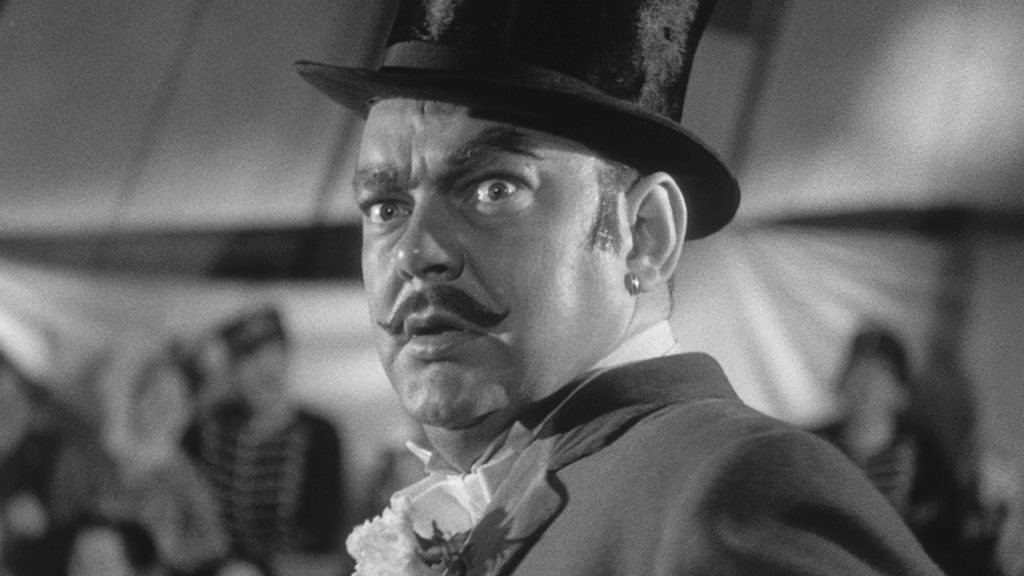
Seven years and thirteen films into the master Swedish director’s career, 35-year-old Ingmar Bergman directed his first film masterpiece. Also the same year that Bergman took over the directorship of the city theatre in provincial Malmö, both a location he would return to in later films and where he would form many of the key artistic collaborations of his later career, it seems appropriate that this stark, brooding meditation on the nexus between art and artifice should find its subject in the dramatic culture clash between the theater and the circus. Set in the late 19th century, Albert Johansson (Åke Grönberg), ringmaster and manager of a failing traveling circus, returns to the seaside town where many years before he abandoned his wife (Annika Tretow) and children, leaving behind a comfortable bourgeois shop trade for a performing vagabond’s life on the open road. With his mistress, the beguiling equestrienne Anne (Harriet Andersson), Albert visits the local theater upon arrival in town to beg for costumes and supplies, and the humiliation received through the theater troupe’s superior attitude is only exacerbated when the company’s lead actor, the charismatic but reptilian Frans (Hasse Ekman), later seduces and cruelly deceives the naïve Anne. Photographed by Hilding Bladh and, working for the first time in what would later prove a career-long association, Sven Nykvist, the shadowy and sinister imagery of the bleak, windswept landscape and the cramped, patch-sewn interiors of the not-so-Big Top — exhausted horses, miserable clowns, and an emaciated bear sludging through the sawdust — visually counters the tinsel glamor of most other circus spectacles to tragic screen effect.
Bronco Billy
1980, Warner Bros., dir. Clint Eastwood
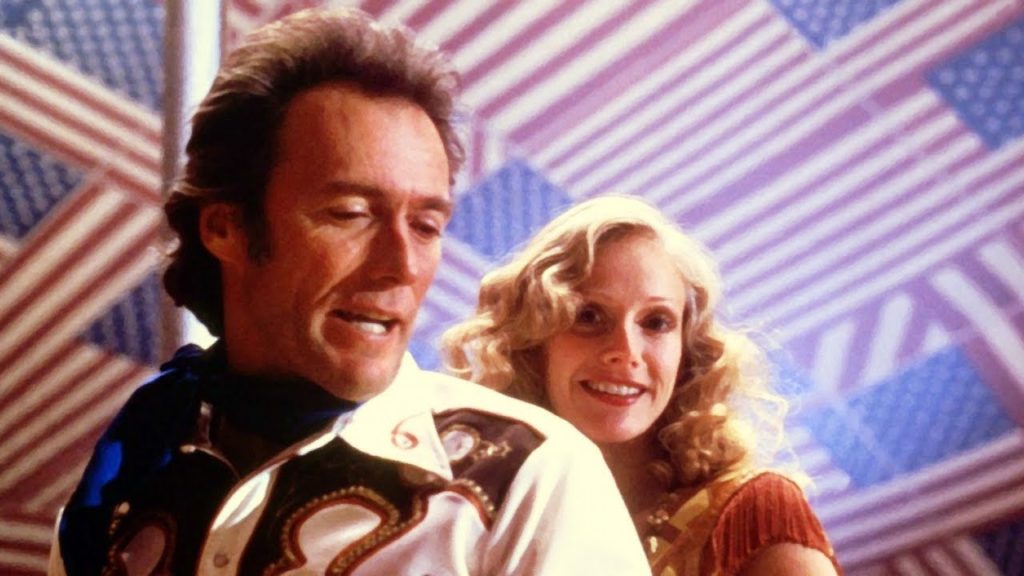
If not the screen cowboy and old movie-style auteur’s least well-regarded effort, 1980’s traveling circus and Wild West show saga Bronco Billy is certainly director and star Clint Eastwood’s least well-known, but even a casual one-time viewing may turn this small-scale showbiz journey though the modern-day West (as of the early 1980s) into many viewers’ most well-loved. Clint is ‘Bronco’ Billy McCoy, a former New Jersey shoe salesman and now self-styled sharp-shooting, rough-riding cowboy hero, who is owner and manager of a constantly failing Western highway-traveling Wild West and Big Top circus show. With always-welcome screen faces like Scatman Crothers, Bill McKinney, Sam Bottoms, and Dan Vadis on hand, rounding out Bronco Billy’s loyal though rarely-paid performers, the gently comic characters and dusky twilight setting is overlong for its 116-minute running time, but is never short on mellow charm or genuine affection for its laid-back milieu. Merle Haggard shows up as himself at a honky-tonk halfway through the breezy proceedings – energetically growling “Misery and Gin” just before a bar brawl inevitably breaks – and seems to sum up in his grizzled person and performance the lingering romance of the long-settled frontier. “Are you for real?”, asks spoiled Eastern heiress Antoinette (Sandra Locke) when first confronted by Billy’s romantic though somewhat deluded self-image as a shining example to Western youth. “I’m who I want to be” is Billy/Clint’s perfect response, and the character’s investment in the broken dreams, ex-convicts, and decidedly un-genuine chintzy trappings that make up his ramshackle traveling show – whose tents have to be mended by inmates of an insane asylum where, free of charge, they yearly perform – nonetheless ends up creating precisely the patriotic kidshow spectacle he envisions The Bronco Billy Wild West Show to be.
Big Fish
2003, Columbia Pictures, dir. Tim Burton

Delusion and self-creation also constitutes a strong point of departure for our third spectacle-themed offering, with Big Fish‘s storyteller Edward Bloom – played by Albert Finney as a dying older man and Ewan McGregor as an heroic younger man – exasperating his grown son (Billy Crudup) through each groan-inducing tall tale and reality-frustrating folk yarn. Mythologizing his own life with stories of witches, giants, werewolves, and regional poets, Edward Bloom is the hero of his own life who caught a “big fish” the day his son was born, relegating his progeny to just another plot point in the continuing saga of this Paul Bunyan-like traveling salesman of the Deep South. Undoubtedly obvious from the three introductions to this circus movie marathon, in which I humbly mythologize an outsize relative of my own, Big Fish is particularly resonant for this viewer and circus movie list-compiler, and the film’s midsection, where Bloom recounts his courtship through hard labor at a circus – monthly learning one thing about a girl momentarily glimpsed at a 3-ring show as sole payment – is for me enchanting even beyond the storyteller’s considerable ability to recount his Herculean tasks. Tim Burton’s mastery of the medium is evinced in the slow-motion capture of a golden-haired beauty glanced through the circus scene of rain-falling glitter, bright-spangled costumes, and high-flying spectacle, and alone earns its place on any self-respecting circus movie list.
Billy Rose’s Jumbo
1962, MGM, dir. Charles Walters
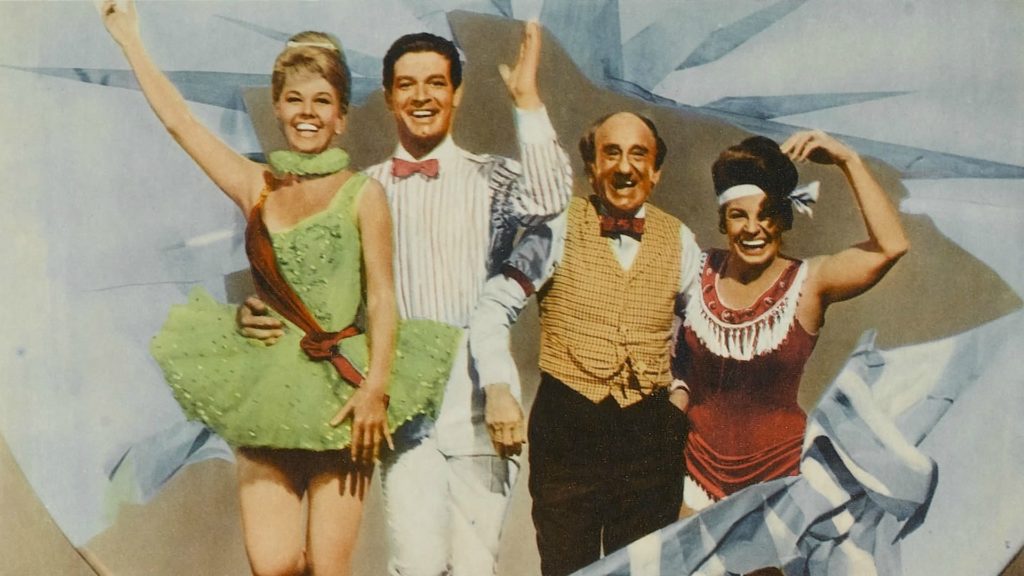
This Broadway spectacle circus musical – and how many of there are those? – took a long, winding adaptational tour of its own following its November 16, 1935 premiere at the New York Hippodrome theater before finally appearing on screens some three decades later as a Panavision and Metrocolor movie spectacle. The stage show’s producer, Billy Rose, somehow stipulated that the musical known as Jumbo appear as Billy Rose’s Jumbo if the Richard Rodgers-scored, Lorenz Hart-penned ever reached the screen, with Jimmy Durante’s “Pop” Wonder and a handful of songs being the only holdovers from the original production. My own viewing of the musical story of a performing pachyderm saving a failing circus is perhaps colored somewhat by A Confederacy of Dunces (1980) scribe John Kennedy Toole’s hilarious description of overweight malcontent and comic anarchist Ignatius Jacques Reilly’s contemporary viewing of this very film in a seedy New Orleans grindhouse – furiously obsessed by star Doris Day and, more specifically, her infuriatingly perfect dental work while trapeze-swinging in giant close-up of that brilliant and blinding smile – but I nevertheless found much other entertainment value in the over-production values of MGM at their glitziest and glossiest. The pageantry of the final Big Top-themed numbers may approach phantasmagoria – with fantasy sets, songs, and costumes changing at a rate to defy accurate description here – but, heck, the circus at its best is nothing without overkill, anyway.
Water For Elephants
2011, 20th Century Fox, dir. Francis Lawrence

Based on the 2006 bestseller by Sara Gruen, Water For Elephants is the story of a young Polish veterinarian who joins a mid-size traveling railway circus during the early years of the Depression and is assigned to train a newly-acquired elephant; his gentle handling of the outsize animal leading to romantic involvement with the sadistic circus owner and ringmaster’s beautiful bareback horse-rider wife. Told in flashback, with the veterinarian now an old man, the events depicted directly precede the eventual demise of the circus, in which the ill-treatment of both its laborers and its wild animal menagerie result in a spectacular circus stampede. I was recommended the book by many who knew my grandfather, being told that the main character was “just like Dean”, though felt in finally reading Water For Elephants that I somehow should have liked it more than I did. The movie adaptation, starring Robert Pattinson as the circus vet, Reese Witherspoon as the bareback rider, and Christoph Waltz as her troubled, abusive husband, at least looks beautiful, with cinematographer Rodrigo Prieto gifting the circus midway with an amber glow nicely befitting the dawn hours of preparation and setup for the next evening performance, but like the book, the unconvincing romance at the center of the Big Top proceedings somehow failed to register for this viewer. (Likewise, the heavily CGI-ed stampede climax of the film, with tigers, bears, and ostriches zooming across the screen like velociraptors from Jurassic Park, probably only deserves to be mentioned parenthetically.) Made in partial cooperation with Baraboo’s Circus World Museum, who supplied most of the vintage circus wagons seen on-screen, the producers “thanked” one of the country’s most invaluable historical resource organizations by misspelling their town name “Barraboo” in the end credits – an oversight my grandfather, with his spot-rigger’s eye for detail, definitely would not have appreciated!
Buffalo Bill and the Indians, or Sitting Bull’s History Lesson
1976, United Artists, dir. Robert Altman
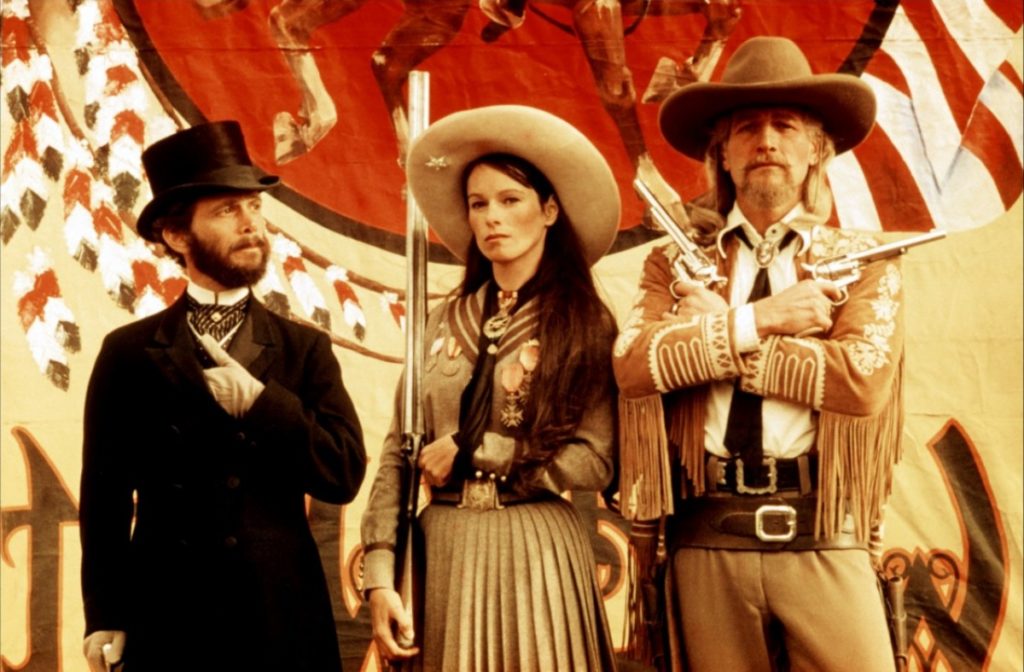
Director Robert Altman, fresh off his 1975 masterwork Nashville, eviscerates the mythology of the Great American Frontier through his typical keen-eyed yet off-center view on the mosaic of personalities surrounding several performances of Buffalo Bill Cody’s 1885 Wild West Show. Starring Paul Newman as the grand Western hero, with his golden flowing locks and twirling pair of glint-edge and pearl-inlaid pistols, the empty bluster of the showman’s overbearing manner is only matched by the dubious authenticity of the spectacles daily staged in all their horse-ridin’, pistol-packin’, whoopin’ and hollerin’ glory; the “white man” ‘triumphing’ in defeat, even, as Cody “heroically” depicts Custer’s own golden flowing locks meeting their tragic, Last Stand demise at the Battle of Little Big Horn. (Undoubtedly no accident that the defining event of the nation’s centennial summer – occurring on June 26th, 1876 – should coincide with its satirically mocking depiction in Altman’s film – premiering June 24th, 1976 – precisely 100 years later, during the nation’s bicentennial summer!) With hilarious turns from Burt Lancaster, functioning as sardonic narrator while spinning drunken poetic reveries as Buffalo Bill’s biographer Ned Buntline; Kevin McCarthy, as Cody’s grizzled old saddlebum pal and trailhand Major Burke; Joel Grey, as opportunistic and ever-inventive show manager Nate Salisbury; and Geraldine Chaplin, as fearless yet broken-armed sharp-shooter Annie Oakley, with John Considine her gun-shy human target/husband Frank E. Butler; Buffalo Bill etc. lays bear the legend of the West even as national outlaw Sitting Bull himself (Frank Kaquitts) joins the show, indirectly communicating his contempt for Cody & Co. through an imposing 7-foot-tall interlocutor named Halsey (Will Sampson). Un-climactically communicating that justifiable contempt (in a larger, national sense) through a rather wonderful non-assault on audience-member and standing US “Great Father”, Grover Cleveland (Pat McCormick) – a perfect complement to the famed climactic moment of Nashville, come to think of it – Sitting Bull essentially (sub)title-emerges victorious in defeat. We may not have learned much in 100 years, and much less in an additional 141 years beyond that, but Sitting Bull’s History Lesson may resonate further even as the 241-year spectacle called AMERICA! continues to off-key croak its un-singable National Anthem.
Circus World
1964, Paramount Pictures/Rank Organization, dir. Henry Hathaway

Shot in Technicolor, Super Technirama 70, and recorded in 6-Track Westrex sound, Circus World Roadshow-ed its way through the various Cinerama-equipped theaters across the country, the largest circus-themed movie – at least in terms of scale – then attempted, realized as a super screen spectacle by shady international financing, questionable labor practices, and a location tax break in Franco’s Spain. International producer/showman Samuel Bronston made a series of historical movie epics in the late 50s through the mid-60s, beginning with King of Kings and El Cid (both 1961) and continuing through 55 Days at Peking and The Fall of the Roman Empire (1963 and ’64), of which Circus World could probably be considered the culmination of an outsize ambition that probably did not bear too close scrutiny on a business ledger. In terms of lavish style and subject matter, however, Circus World definitely lives up to its title, its turn-of-the-twentieth century European setting a grand Big Top tour of the continent, with never less than three rings spreading across the screen’s arena length. John Wayne stars as Wild West show proprietor, rider, and marksmen Matt Masters, whose own outsize ambition – with a good deal of chutzpah and vision to match – manages to combine the American mythical element of shows like Buffalo Bill’s with the European art circus trappings of master trapeze flier Lillian Leitzel. Rita Hayworth and Claudia Cardinale co-star as a mother/daughter amalgamation of that latter, legendary circus performer, and if their combined high-flying, one-armed pull-bar plunges are doubled, the performance and spectacle aspects of Circus World seem entirely authentic.
The Greatest Show On Earth
1952, Paramount Pictures, dir. Cecil B. DeMille
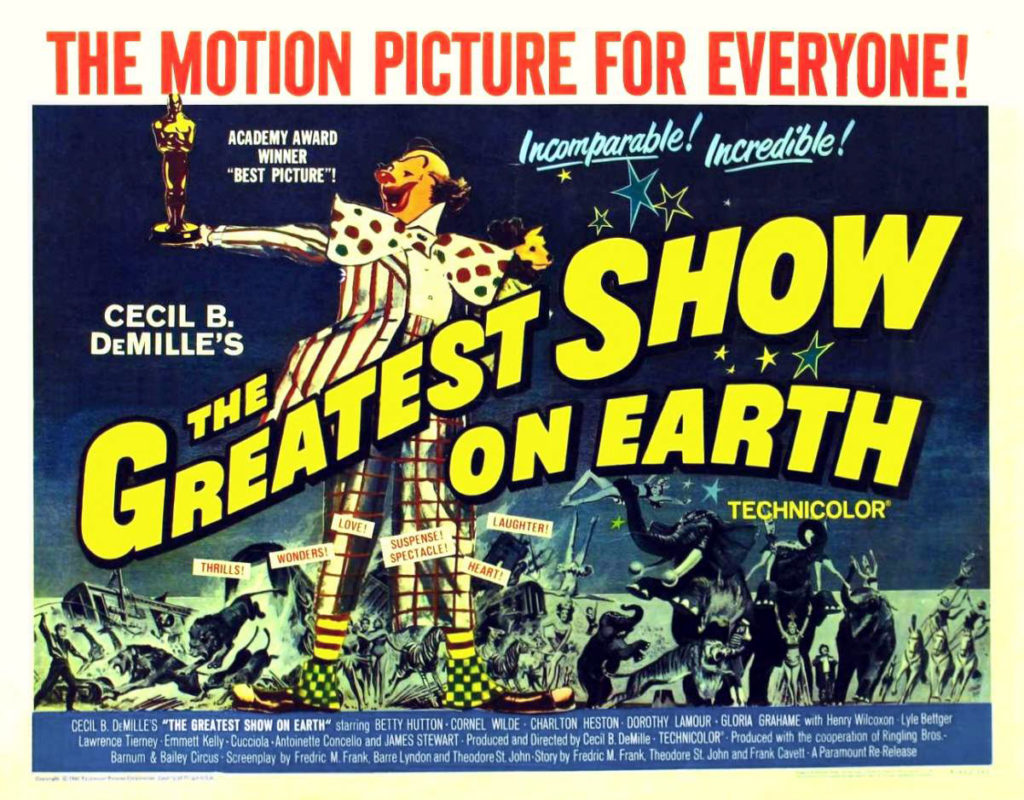
Pure screen hokum courtesy of the cinematic master of pure screen hokum, I’d venture the more than appropriately titled The Greatest Show On Earth is the film Cecil Blount DeMille was born to make. A marvelously melodramatic big screen circus extravaganza, the all-star cast, mammoth set pieces, and complete cooperation of the 1951 season Ringling Bros. and Barnum & Bailey Show, along with its owner and manager John Ringling North (who appears on-screen as himself), The Greatest Show On Earth is for this viewer as ridiculously entertaining as for other viewers it might be merely ridiculous. Charlton Heston is at his stentorian best as manager Brad Braden, barking orders on the midway even as he harbors a secret passion for high-flying Betty Hutton as lady trapeze artist Holly. An almost too-suave and hunky Cornel Wilde soon arrives as showboat center ring trapeze performer The Great Sebastian, complete with a foreign “accent” not readily recognized, perhaps, in his supposed country of origin, to add the inevitable third angle to a circus film’s de rigueur romantic configuration of convention and choice. Climaxing in a spectacular nighttime railway crash which no less than Steven Spielberg credits as inspiring his entire effects-driven career, the real-life Ringling acts and performers appearing in charmingly unconvincing process shots behind James Stewart, as clown/runaway mercy-killing doctor Buttons, or Dorothy Lamour, as a South Seas Spec singer/butterfly-costumed iron-jaw aerialist, offer a panorama of big screen spectacle to match the size and scale of the great circus spectacle. Possibly the most widely-ridiculed recipient of the Academy Award for Best Picture, which it won in 1952 along with an Oscar for Best Story, the film simply defies criticism for those viewers willing to suspend their disbelief and open their peanuts-and-popcorn, sawdust-and-tinsel, cotton-candied hearts to the THRILLS! CHILLS! SUPER DRAMATIC SPILLS! of a show that truly lives up to the hyperbole of its all time-trademarked tagline.

